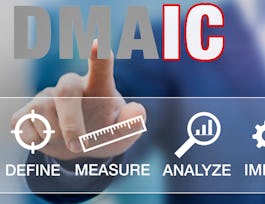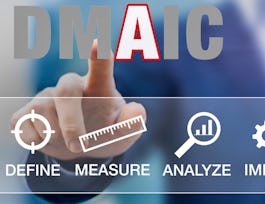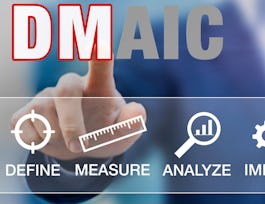The course will equip you with the competencies and essential skills required to excel in the American Society for Quality (ASQ) Certified Six Sigma Yellow Belt (CSSYB) exam and contribute to process improvement programs. This course focuses on various data collection tools and techniques to analyze data, identify the root causes of a problem, and explore the concepts of measurement system analysis (MSA), and hypothesis testing.



Data Collection and Root Cause Analysis
This course is part of ASQ-Certified Six Sigma Yellow Belt Exam Prep Specialization Specialization


Instructors: Skill-Up EdTech Team
Sponsored by BrightStar Care
Recommended experience
What you'll learn
Define data requirements to gather relevant data from the process using appropriate data collection methods.
Calculate baseline process performance metrics based on the collected data.
Analyze data for variations and use data analysis tools and techniques to identify the root causes for the problem or variation.
Details to know

Add to your LinkedIn profile
9 assignments
See how employees at top companies are mastering in-demand skills

Build your subject-matter expertise
- Learn new concepts from industry experts
- Gain a foundational understanding of a subject or tool
- Develop job-relevant skills with hands-on projects
- Earn a shareable career certificate


Earn a career certificate
Add this credential to your LinkedIn profile, resume, or CV
Share it on social media and in your performance review

There are 4 modules in this course
This module introduces you to descriptive statistics, a branch of statistics that involves summarizing and describing the main features of a dataset. It provides tools and techniques to organize, present, and analyze data to gain insights into its central tendencies, variability, and distribution. Descriptive statistics is fundamental in data analysis and is a basis for more advanced statistical methods. You will also be introduced to inferential statistics. The module also explains the various data types and helps you differentiate between qualitative and quantitative data and data coming from internal and external sources. It describes the data collection process. Further, the module delves into the concept of measurement system analysis (MSA) and its components to understand the variations in the measurement process.
What's included
7 videos2 readings3 assignments1 discussion prompt
This module explains the differences between value-added and non-value-added activities. It makes a case for non-value-added activities that are necessary to enable the smooth running of the organization. The module also discusses how to identify the bottlenecks in a system and suggests ways to eliminate them. Lastly, the module explores the various techniques to conduct a root cause analysis (RCA) for the identified problem in your process or organization. The first one, Pareto analysis, is based on the Pareto principle, which states that approximately 80% of the effects come from 20% of the causes. This analysis helps prioritize potential root causes based on their relative impact. You will also learn how to use the fishbone diagram, also known as the Ishikawa or cause and effect diagram, which visually represents the potential causes contributing to a problem while categorizing the possible causes into specific groups to facilitate the identification of root causes. Additionally, you will learn about the five whys, a simple yet powerful technique involving repeatedly asking “why” to identify the root cause of a problem. It helps to peel the layers of symptoms and surface-level causes to get to the core issue.
What's included
5 videos1 reading3 assignments1 discussion prompt
This module provides a comprehensive overview of hypothesis testing, an essential statistical tool used to assess the validity of claims or hypotheses about populations. You will learn about the hypothesis testing process, its application in real-world scenarios, and how to interpret the hypothesis test results to make better decisions. The module will take you through the different types of hypotheses, types of errors, and the significance of the p-value in hypothesis testing. You will also learn about the principles and applications of correlation and regression techniques. The module discusses the types of correlation and the roles of dependent and independent variables in regression analysis. lt explains the implications of R-squared values in regression analysis. The module also explains simple linear regression and the difference between deterministic and probabilistic models.
What's included
8 videos1 reading3 assignments1 discussion prompt
This is a peer-review assignment based on the concepts taught in the Data Collection and Root Cause Analysis course. In this assignment, you will apply your knowledge of hypothesis testing to a real-life scenario.
What's included
1 video2 readings1 peer review
Offered by
Why people choose Coursera for their career




Recommended if you're interested in Data Science

Kennesaw State University

Kennesaw State University

Kennesaw State University

Kennesaw State University

Open new doors with Coursera Plus
Unlimited access to 10,000+ world-class courses, hands-on projects, and job-ready certificate programs - all included in your subscription
Advance your career with an online degree
Earn a degree from world-class universities - 100% online
Join over 3,400 global companies that choose Coursera for Business
Upskill your employees to excel in the digital economy


